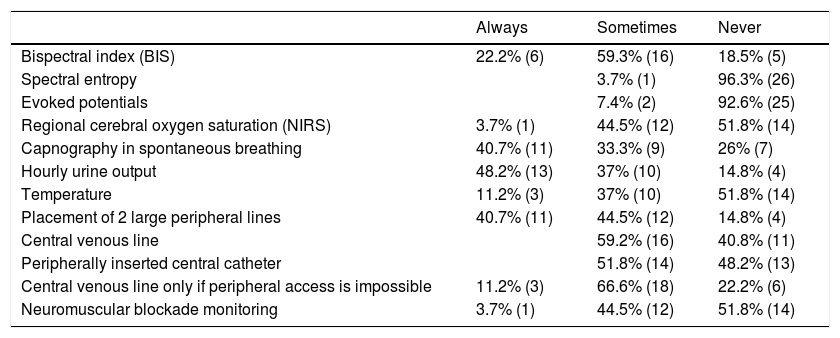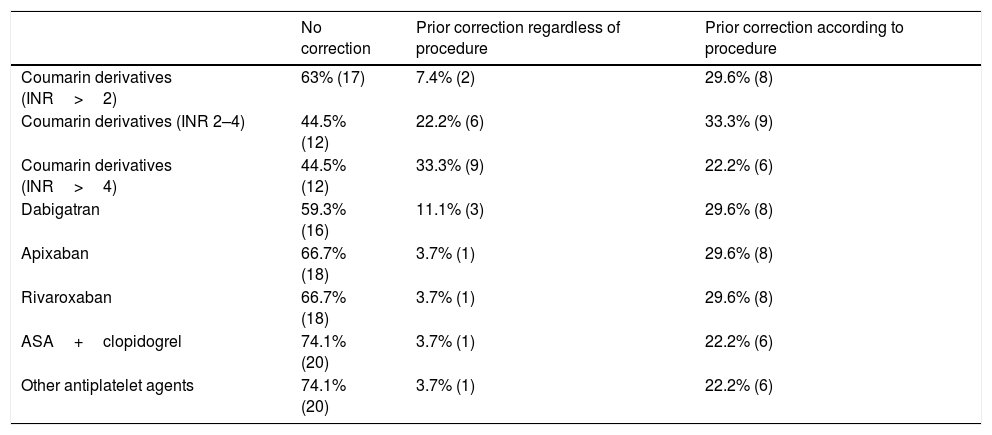To assess the anaesthetic management of treatment for endovascular acute ischaemic stroke (AIS) in Spain.
Materials and methodA survey was designed by the SEDAR Neuroscience Section and sent to the Spanish anaesthesiology departments with a primary stroke centre between July and November 2016.
ResultsOf the 47 hospitals where endovascular treatment of AIS is performed, 37 anaesthesiology departments participated. Thirty responses were obtained; three of which were eliminated due to duplication (response rate of 72.9%). Health coverage for AIS endovascular treatment was available 24h a day in 63% of the hospitals. The anaesthesiologist in charge of the procedure was physically present in the hospital in 55.3%. There was large inter-hospital variability in non-standard monitoring and type of anaesthesia. The most important criterion for selecting type of anaesthesia was multidisciplinary choice made by the anaesthesiologist, neurologist and neuroradiologist (59.3%). The duration of time from arrival to arterial puncture was 10–15min in 59.2%. In 44.4%, systolic blood pressure was maintained between 140 and 180mmHg, and diastolic blood pressure <105mmHg. Glycaemic levels were taken in 81.5% of hospitals. Intravenous heparinisation was performed during the procedure in 66.7% with different patterns of action. In cases of moderate neurological deterioration with no added complications, 85.2% of the included hospitals awakened and extubated the patients.
ConclusionsThe wide variability observed in the anaesthetic management and the organisation of the endovascular treatment of AIS demonstrates the need to create common guidelines for anaesthesiologists in Spain.
Conocer la práctica clínica habitual de los anestesiólogos españoles en el manejo del tratamiento endovascular del infarto isquémico cerebral agudo (IIA).
Materiales y métodosEncuesta diseñada desde la Sección de Neurociencias de la SEDAR, enviada a todos los servicios de anestesiología en hospitales españoles con unidad de referencia de ictus, entre julio y noviembre de 2016.
ResultadosDe los 47 hospitales donde se realiza tratamiento endovascular del IIA, en 37 participa el servicio de anestesiología. Obtuvimos 30 respuestas, eliminándose 3 por duplicidad (tasa de respuesta del 72,9%). El 63% de los hospitales tiene cobertura asistencial para el tratamiento endovascular del IIA las 24 h del día. El anestesiólogo encargado es el de presencia física en el hospital en un 55,3%. Existe gran variabilidad interhospitalaria en la monitorización no estándar y el tipo de anestesia. El criterio más empleado para su elección, es una decisión consensuada entre anestesiólogo, neurólogo y neurorradiólogo (59,3%). El tiempo transcurrido desde el inicio de la técnica anestésica hasta la punción arterial en un 59,3% es de 10–15 min. En un 44,4%, se mantiene una presión arterial sistólica entre 140-180mmHg y diastólica <105mmHg. El control de la glucemia se realiza en un 81,5% de los hospitales. El 66,7% (18) lleva a cabo una heparinización endovenosa durante el procedimiento pero con un régimen muy variado. El 85,2% coincide en la educción y extubación del paciente al final del procedimiento en caso de deterioro neurológico leve o moderado sin complicaciones añadidas.
ConclusionesLa gran variabilidad observada en el manejo anestésico y organización del tratamiento endovascular del IIA, pone de manifiesto la necesidad de crear unas pautas de actuación comunes entre los anestesiólogos de España.












